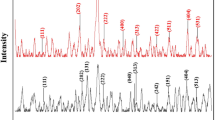Abstract
The present work describes the application of radiotracer technique for studying uptake of arsenic on titanium hydroxide, commercial titanium dioxide (TiO2) powder (anatase) and synthesized mesoporous titania beads in acidic, neutral, and alkaline conditions. Sol–gel templating method was used to prepare titania–polysaccharide composites, with different polymer contents. Mesoporous titania was obtained by heat treatment of the composite beads in a controlled environment. The synthesis process was optimized, using thermogravimetry analysis. X-ray diffraction patterns confirmed the formation of anatase pure phase titania (TiO2) at 700 °C in different environments, and scanning electron microscopy studies confirmed uniform pore size distribution. The effect of surface area, polymer content and pH on uptake of arsenic(III) and (V) on the synthesized titania beads was also investigated. Arsenic(V) was found to be retained quantitatively on the titania beads synthesized from 0.8% polymer content titania–polymer composite precursor in neutral to alkaline conditions. Details of the results obtained are discussed.





Similar content being viewed by others
References
Kiplin MD (1977) In: Lenihan J, Fletcher WW (eds) Arsenic, the chemical environment, environment and man, vol 6. Blackie, Glasgow, p 93
Pershagen G (1983) In: Fowler BA (ed) The epidemiology of human arsenic exposure. Elsevier, Amsterdam, p 199
Tseng WP (1977) Environ Health Perspect 19:109
Saha KC (1984) Indian J Dermatol 29:37
Saha KC (1995) Indian J Dermatol 40:1
Narang AP (1987) J Toxicol Clin Toxicol 25:287
Mandal BK (1996) Curr Sci 70:976
Dhar RK (1997) Curr Sci 73:48
Mamtaz R, Bache DH (2001) In: Low-cost technique of arsenic removal from water, p 43
Ahmed MF (2001) In: Technologies for arsenic removal from drinking water, p 251
Cheng CR, Liang S, Wang HC, Beuhler MD (1994) J Am Water Works Assoc 86(9):79
Hering JG, Chen PY, Wilkie JA, Elimelech M, Liang S (1996) J Am Water Works Assoc 88(4):155
Hering JG, Chen PY, Wilkie JA, Elimelech M (1997) J Environ Eng ASCE 123(8):800
Raje N, Swain KK (2002) J Radioanal Nucl Chem 253(1):77
Liu K, Zhang M, Shi K, Fu H (2005) Mater Lett 59:3308
Jézéquel H, Chub KH (2006) J Environ Sci Health, A 41(8):1519
Said AA, Hassan RM (1993) Polym Degrad Stab 39:393
Belapurkar AD, Sherkhane P, Kale SP (2006) Curr Sci 91(1):73
Du KF, Yang D, Sun Y (2009) Ind Eng Chem Res 48:755
Duvarci OC, Ciftcioglu M, Guden M, Arıkut G (2004) Key Eng Mater 264–268:2355
Burdett JK (1987) J Am Chem Soc 109:3639
Yang H, Lin WY, Rajeshwar KJ (1999) Photochem Photobiol A Chem 123:137
Yunjoolee H, Choi IW (2002) Environ Sci Technol 36:3872
Acknowledgments
The author Charu Dwivedi is grateful to BRNS, Department of Atomic Energy for awarding research fellowship. The authors are thankful to Dr. C. G. S. Pillai for SEM, Dr. R. K. Singhal for providing Zetasizer facility and Ms. Darshana K. Ghonge for her help during thermoanalytical measurements. The authors also wish to acknowledge Dr. T. Mukherjee, Director Chemistry Group and Dr. S. K. Sarkar, Head Radiation and Photochemistry Division, Shri R. Kameswaran for their encouragement during the course of the study.
Author information
Authors and Affiliations
Corresponding authors
Rights and permissions
About this article
Cite this article
Dwivedi, C., Raje, N., Kumar, M. et al. Application of synthesized mesoporous titania microspheres for arsenic [(III) and (V)] uptake studies. J Radioanal Nucl Chem 294, 131–136 (2012). https://doi.org/10.1007/s10967-011-1555-3
Received:
Published:
Issue Date:
DOI: https://doi.org/10.1007/s10967-011-1555-3




